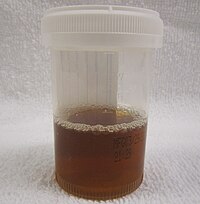
Photo from wikipedia
OBJECTIVES Early recognition of refractory status epilepticus (RSE) is essential to select an appropriate treatment strategy and is closely associated with the outcome. Only few studies of RSE biomarkers exist;… Click to show full abstract
OBJECTIVES Early recognition of refractory status epilepticus (RSE) is essential to select an appropriate treatment strategy and is closely associated with the outcome. Only few studies of RSE biomarkers exist; hence, we investigated the serum levels of uric acid (UA), albumin, and C-reactive protein (CRP) as potential serologic biomarkers for RSE. PATIENTS AND METHODS Consecutive status epilepticus (SE) patients who had serial conventional blood tests in a referral hospital over a period of 10 years were retrospectively analyzed. Patients with anoxic encephalopathy, renal failure, acute stroke, and myocardial infarction were excluded. RSE was defined as seizure continuing after the first- and second-line treatments. We also assessed SE severity in all included patients using the Status Epilepticus Severity Score (STESS). General demographics and blood test findings were compared between responsive SE and RSE patients. RESULTS A total of 141 patients (99 responsive and 42 refractory) were recruited from our SE registry. Compared to responsive patients, patients with RSE showed a higher STESS, lower initial albumin levels, lower initial UA levels, lower follow-up UA levels, and greater reduction of UA levels. The RSE group more frequently had acute symptomatic etiology, showed longer hospitalization, and had poorer functional outcomes compared to the responsive-SE group. All evaluated UA level parameters exhibited significant areas under the curve in receiver operating characteristic analyses, predictive of RSE. Initial UA levels, as well as changes therein, were significantly associated with RSE in multivariate logistic regression analysis. CONCLUSION UA levels at initial and follow-up evaluations, and changes therein differentiated responsive SE and RSE, demonstrating the feasibility of UA serum levels as a biomarker for RSE.
Journal Title: Clinical Neurology and Neurosurgery
Year Published: 2019
Link to full text (if available)
Share on Social Media: Sign Up to like & get
recommendations!